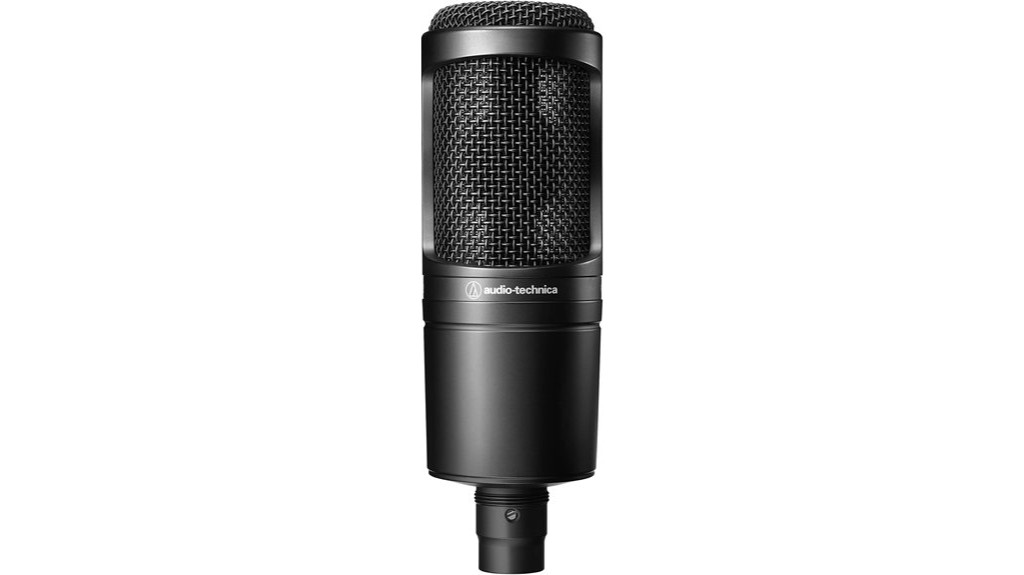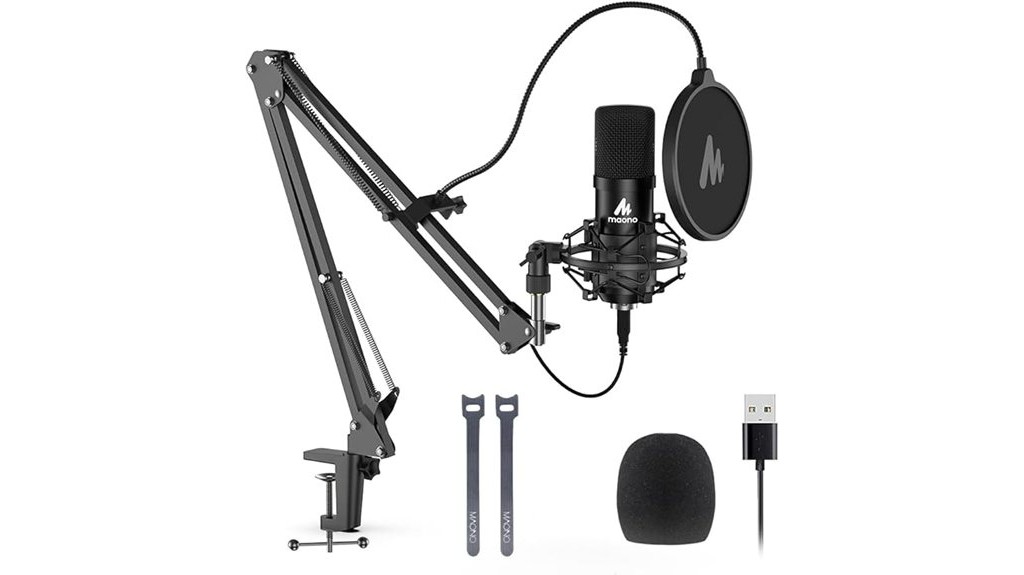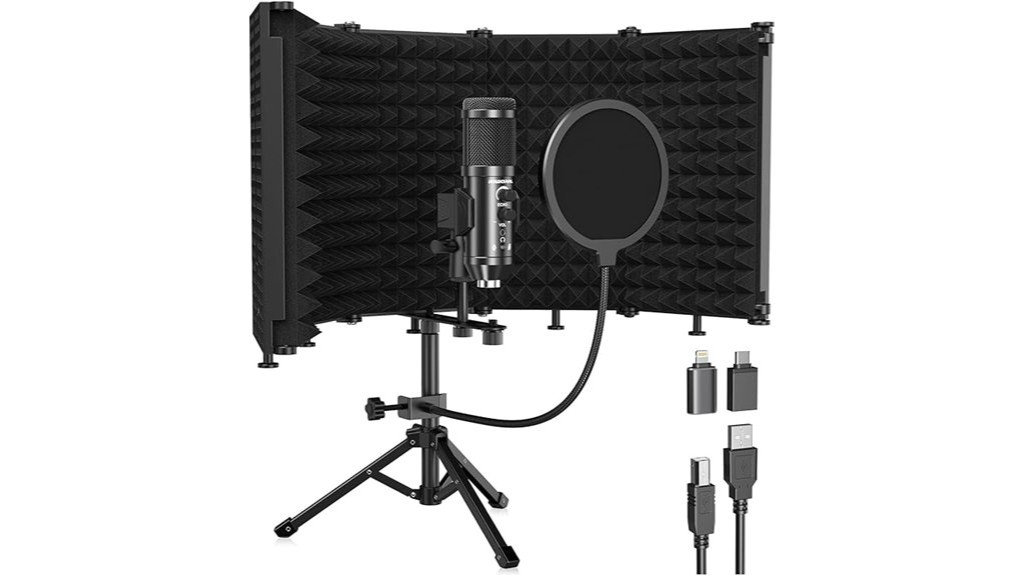This post may contain affiliate links, and we may receive commission if you purchase any of the products listed below.
As 2025 wraps up, you’re probably on the lookout for the best studio condenser microphones to elevate your instrument recordings. This guide highlights the standout options that blend cutting-edge technology with superior audio quality. From the versatile RØDE NT-USB Mini to the value-packed MAONO kits, these microphones cater to various needs and budgets. Discover which of these top picks can transform your studio setup and enhance your sound.
RØDE NT-USB Mini Condenser USB Microphone for Various Recording Uses
The RØDE NT-USB Mini Condenser USB Microphone is a top choice for anyone seeking studio-quality sound for a variety of recording applications. Whether you’re into podcasting, gaming, or music production, this microphone delivers warmth and presence ideal for vocals and instruments. Its simple plug-and-play setup means you won’t need extra software. Enjoy precise sound with the integrated noise gate and compressor, plus enhanced audio through the RØDE Connect software. Weighing 585 grams, it’s compact but sturdy. While it lacks a mute button, users praise its sound clarity and ease of use. It’s a bit pricier, but the quality justifies it.
Best For: Individuals seeking studio-quality sound for podcasting, gaming, and music production with ease of use and exceptional clarity.
Pros:
- High-quality sound with tailored warmth and presence.
- Simple plug-and-play setup with no additional software required.
- Integrated noise gate and compressor enhance audio precision.
Cons:
- Lacks a mute button for quick silencing.
- Hefty design may affect portability without a dedicated case.
- Higher price point compared to some competitors.
Check Price on Amazon
Audio-Technica AT2020 Cardioid Condenser Studio Microphone
Looking for a versatile and reliable microphone for your home studio? The Audio-Technica AT2020 Cardioid Condenser Studio Microphone might be your perfect match. With excellent sound quality and a wide dynamic range, it’s ideal for project studios. Its cardioid polar pattern enhances sound isolation, while the custom-engineered diaphragm guarantees superior transient response. Although it requires phantom power and soundproofing for best results, users praise its clarity and ability to rival pricier models. Whether you’re into voice acting, podcasting, or gaming, the AT2020 offers exceptional value. Just remember, it’s sensitive to background noise, so maintain a controlled environment.
Best For: Home studio enthusiasts and professionals seeking a high-quality microphone for voice acting, podcasting, and gaming, who can maintain a controlled recording environment.
Pros:
- Excellent sound quality for the price
- Durable construction
- Versatile for various applications (vocals, gaming, podcasting)
Cons:
- Sensitive to background noise; requires soundproofing for optimal use
- Requires phantom power for best performance
- May not be ideal for environments with significant ambient noise
Check Price on Amazon
MAONO USB Microphone Kit (AU-A04)
For budding musicians and seasoned audio professionals alike, the MAONO USB Microphone Kit (AU-A04) offers an ideal blend of quality and convenience. With its large diaphragm condenser design, this mic delivers crisp sound quality, thanks to a 192kHz/24Bit professional sound chipset. You don’t need any special software—just plug it into a USB port and start recording. Its versatility shines through with compatibility across laptops, PCs, and mobile phones (with an OTG adapter). Plus, the kit includes a pop filter, shock mount, and boom arm for pristine audio and stable setups. It’s a top choice for any serious musician.
Best For: Budding musicians and seasoned audio professionals seeking a high-quality, convenient, and versatile USB condenser microphone for recording.
Pros:
- Plug and play USB connection, eliminating the need for additional software.
- High-quality sound with a 192kHz/24Bit professional sound chipset.
- Comprehensive kit includes accessories like a pop filter, shock mount, and boom arm for stable and clear recordings.
Cons:
- Requires an OTG adapter for use with mobile phones.
- Limited frequency response range of 30Hz-16kHz.
- Single-channel audio may not suit multi-track recording needs.
Check Price on Amazon
MAONO XLR Condenser Microphone (PM320S)
Seeking a reliable microphone for versatile audio tasks? Check out the MAONO XLR Condenser Microphone (PM320S). This professional cardioid studio mic is perfect for streaming, podcasting, and vocal recordings. With a robust metal build and adjustable boom arm, it offers durability and flexibility. Its cardioid pattern reduces ambient noise, while the built-in 16 mm condenser capsule guarantees extended frequency response from 20 Hz to 18 KHz. You’ll appreciate its included accessories like a pop filter and shock mount. Users love its sound quality and affordability, making it a top pick for both beginners and seasoned creators.
Best For: Beginners and content creators seeking an affordable, high-quality microphone for versatile audio tasks like streaming, podcasting, and vocal recordings.
Pros:
- Excellent sound quality with extended frequency response.
- Durable metal construction with a foldable boom arm for easy transport.
- Includes useful accessories like a pop filter and shock mount.
Cons:
- Requires 48V phantom power, which may not be immediately available to all users.
- Initial power setup issues reported by some users.
- May not perform optimally in untreated recording environments.
Check Price on Amazon
Studio Recording Microphone with Isolation Shield and Pop Filter
If you’re searching for a versatile recording solution, the Studio Recording Microphone with Isolation Shield and Pop Filter is an excellent choice for musicians, podcasters, and vocalists alike. This USB condenser mic is a plug-and-play marvel, compatible with PCs, laptops, and smartphones. With its cardioid polar pattern, it captures pristine audio, boasting a sampling rate of 192kHz/24Bit. The foldable design with five high-density panels guarantees superior sound isolation. Adjust angles for the best acoustics, and enjoy features like echo, volume control, and a headphone jack. Lightweight yet robust, it includes a tripod stand, pop filter, and extension wire for ultimate portability.
Best For: Musicians, podcasters, and vocalists seeking a portable and high-quality recording solution.
Pros:
- Plug-and-play compatibility with PCs, laptops, and smartphones.
- Excellent sound quality with a 192kHz/24Bit sampling rate.
- Foldable design with high-density panels for superior sound isolation.
Cons:
- Limited frequency response range up to 16 kHz.
- Requires USB connection, not suitable for all types of audio interfaces.
- May not be ideal for users seeking a more extensive studio setup.
Check Price on Amazon
Factors to Consider When Choosing Studio Condenser Microphones for Recording Instruments
When you’re choosing a studio condenser microphone for recording instruments, consider factors like frequency response range and sound isolation capabilities. You’ll also want to assess the build and durability, ensuring it can withstand frequent use. Don’t forget to check its connectivity and compatibility with your setup, as well as any noise reduction features it offers.
Frequency Response Range
While choosing a studio condenser microphone for recording instruments, understanding the frequency response range is crucial. This range, measured in Hertz (Hz), determines the microphone’s ability to capture both low and high frequencies. A standard range is 20 Hz to 20 kHz, but wider ranges can be beneficial. If you’re recording bass instruments, look for mics that extend below 20 Hz to capture those deep sounds. For high-frequency detail, choose ones reaching above 20 kHz for clarity. The frequency response curve also affects tonal balance. Some mics enhance specific frequencies, adding warmth to vocals or crispness to cymbals. Matching the microphone’s frequency response to the instruments you’re recording guarantees accurate and high-quality sound reproduction.
Sound Isolation Capabilities
Having explored frequency response range, let’s now focus on sound isolation capabilities—another vital factor when selecting studio condenser microphones for instrument recording. A cardioid polar pattern is essential, capturing sound from the front and minimizing noise from the sides and rear. This design helps you achieve clearer recordings by isolating your intended sound source. Prioritize microphones with a high signal-to-noise ratio, like 82 dB or higher, to further reduce ambient noise. Built-in pop filters and shock mounts are invaluable, cutting down on plosive sounds and vibrations. Additionally, consider using an isolation shield with sound-absorbing panels to create a controlled environment. This setup decreases reflections and external noise, ensuring your recordings are as clean and precise as possible.
Build and Durability
Choosing a studio condenser microphone with solid build quality is essential for ensuring long-term durability. Opt for models with metal construction, as they’re generally more robust than those made from lightweight plastic. While a heavier microphone design can enhance stability during recordings, consider how this might affect portability if you frequently move your setup. Look for microphones with detachable components like boom arms or shock mounts, which add versatility and adaptability to your recording environment. A strong shock mount not only reduces vibration noise but also extends the microphone’s lifespan. Additionally, consider overall design aspects such as foldability, which make transportation easier without compromising on durability. By focusing on these elements, you’ll select a microphone that withstands the test of time.
Connectivity and Compatibility
As you consider studio condenser microphones for recording instruments, pay close attention to their connectivity and compatibility features. Choose between USB microphones for easy plug-and-play use or XLR microphones for a more professional setup needing phantom power. Think about what devices you’ll be recording with; some mics work with PCs and laptops, while others might need adapters for mobile devices. Don’t overlook power requirements—USB mics draw power directly from your device, but XLR mics typically need an external interface. Also, check if the mic’s signal processing capabilities require additional software or hardware. Finally, verify the sampling rate and frequency response specifications to confirm they meet your recording quality needs for different instruments and vocals.
Noise Reduction Features
When selecting studio condenser microphones for recording instruments, noise reduction features play a vital role in ensuring high-quality audio. Opt for microphones with a cardioid polar pattern because they excel at minimizing surrounding noise, honing in on the sound source. Advanced noise reduction technologies, like integrated noise gates and compressors, can further enhance sound clarity by filtering out unwanted background noise. Built-in pop filters and windshields are also essential, as they reduce plosive sounds and wind interference, ensuring clean audio signals. Pay attention to the signal-to-noise ratio (SNR); higher SNR values mean better noise reduction capabilities, which leads to clearer recordings. Additionally, consider using external isolation shields to provide a sound-absorbing barrier, minimizing reflections and ambient noise around the microphone.
Frequently Asked Questions
What Is the Difference Between USB and XLR Microphones for Studio Recording?
USB mics connect directly to your computer, offering plug-and-play simplicity, ideal for home studios. XLR mics require an audio interface, providing better sound quality and versatility, making them suitable for professional setups. Choose based on your recording needs.
How Do Condenser Microphones Compare to Dynamic Microphones for Instrument Recording?
Condenser microphones capture more detail and nuance compared to dynamic microphones, making them ideal for recording instruments. You’ll find condensers are more sensitive and better at capturing high frequencies, while dynamics are durable and handle high sound pressure.
Yes, you can use condenser microphones for live performances, but they’re more sensitive to feedback and handling noise. You’ll need to manage these issues with proper positioning and possibly using a shock mount or pop filter.
What Is the Ideal Frequency Response Range for Recording Musical Instruments?
You should look for a frequency response range of 20Hz to 20kHz. This range captures the full spectrum of sound, ensuring your recordings are rich and detailed. Don’t forget, specific instruments may require tailored adjustments.
How Do I Properly Maintain and Clean a Studio Condenser Microphone?
To maintain and clean a studio condenser microphone, gently use a soft brush for dust, avoid moisture, and store it in a dry, padded case. Regularly check for damage and never blow into the mic.
Conclusion
When choosing the best studio condenser microphone for recording instruments, it’s crucial to take into account your specific needs. The RØDE NT-USB Mini offers versatility with its USB connectivity, while the Audio-Technica AT2020 excels in sound isolation. The MAONO USB Microphone Kit provides excellent value, and the MAONO XLR Condenser Microphone delivers professional performance. Finally, the Studio Recording Microphone with Isolation Shield guarantees pristine sound capture. Evaluate these options to find the perfect fit for your recording projects.








